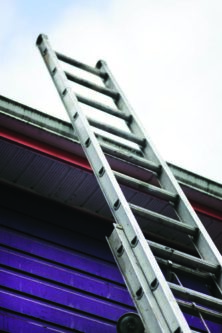Do’s and don’ts of extension ladders

Extension ladders typically have two sections that use brackets or guides to make them adjustable, allowing workers to perform tasks at various heights. However, the Canadian Center for Occupational Health and Safety warns, extension ladders are not self-supporting and require “a stable structure that can withstand the intended load.”
Do’s
Ensure the ladder is placed on a firm, level surface so its footing is secure. Then, erect the ladder so the upper section rests on the bottom section. This will leave the bottom section facing the wall or other supporting structure. CCOHS says the ladder feet should be placed so the horizontal distance between the feet and top support is one-quarter the working length of the ladder, resulting in the ladder leaning at a 75-degree angle from the ground.
Workers should ensure all hooks are secure before climbing, and be careful when getting on or off an extension ladder to avoid tipping it over or causing the ladder base to slide. When workers need access to an elevated work surface, they should erect the ladder so it extends at least 3 feet beyond the landing platform, and then tie off the top at support points. At the base, brace or tie off the ladder. If no structure is available to tie off to, use a stake in the ground. If the ladder will be erected in a doorway or passageway, set up warning signs and barricades.
Don’ts
Keep in mind a number of “don’ts” when using an extension ladder, CCOHS says. For example, never use one near power lines – keep the ladder and any tools at least 10 feet away. Also, don’t:
- Use a ladder unless it has been thoroughly inspected by a trained or competent person.
- Set up or take down a ladder when it’s extended.
- Overextend a ladder.
- Use extension ladders on icy, snowy or slippery surfaces.
For more tips on extension ladders, including how to avoid overexertion while setting up one, visit sh-m.ag/2VL7Hi3.
Post a comment to this article
Safety+Health welcomes comments that promote respectful dialogue. Please stay on topic. Comments that contain personal attacks, profanity or abusive language – or those aggressively promoting products or services – will be removed. We reserve the right to determine which comments violate our comment policy. (Anonymous comments are welcome; merely skip the “name” field in the comment box. An email address is required but will not be included with your comment.)

